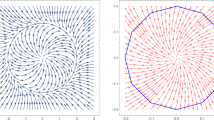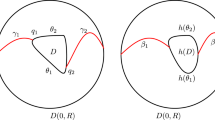Abstract
In this work, we analyze the critical points of potential functions on the torus arising in decentralized formation shape control of multiagent systems on the unit circle. A rotation symmetry of the potential function allows to reduce the analysis to a reduced function on a lower-dimensional torus. We show that these reduced potential functions are generically Morse functions. Lower bounds on the number of critical points of the reduced potential are obtained by Morse-theoretic arguments. For trees, precise information on the number of critical points is obtained. We use algebraic–geometric methods to determine upper bounds on the number of critical points of the reduced potentials. Our approach is applicable both to standard formation control potential functions and potential functions arising from the Kuramoto model of coupled oscillators with identical natural frequencies.
Similar content being viewed by others
Notes
In the sense of complex analysis.
References
Absil PA, Kurdyka K (2006) On the stable equilibrium points of gradient systems. Syst Control Lett 55(7):573–577
Acebrón J, Bonilla L, Vicente C, Ritort F, Spigler R (2005) The Kuramoto model: a simple paradigm for synchronization phenomena. Rev Modern Phys 77:137–185
Anderson BDO, Yu C, Dasgupta S, Summers TH (2010) Controlling four agent formations. In: 2nd IFAC workshop on distributed estimation and control in networked systems. Annecy, France, pp 139-144
Anderson BDO (2011) Morse theory and formation control. In: Proceedings of the 19th Mediterranean conference on control and automation. Corfu, Greece, pp 656-661
Anderson BDO, Helmke U (2014) Counting critical formations on the line. SIAM J Control Optim 52:219–242
Bernstein DN (1975) The number of roots of a system of equations. Funct Anal Appl 9:183–185
Dimarogonas DV, Johansson KH (2008) On the stability of distance-based formation control. In: Proceedings of the 47th IEEE conference on decision and control. Cancun, Mexico, pp 1200-1205
Draisma J, Horobeţ E, Ottaviani G, Sturmfels B, Thomas RR (2016) The Euclidean distance degree of an algebraic variety. Found Comput Math 16:99–149
Gao T, Li TY, Wu M (2005) Algorithm 846: MixedVol: a software package for mixed-volume computation. ACM Trans Math Softw 31(4):555-560. http://doi.acm.org/10.1145/1114268.1114274 ( Online)
Gazi V, Passino KM (2004) A class of attraction/replusion functions for stable swarm aggregations. Int J Control 77(18):1567–1579
Greenberg MJ, Harper JR (1981) Algebraic topology: a first course. Benjamin/Cummings, Reading, Massachusetts
Heintz J (1983) Definability and fast quantifier elimination in algebraically closed fields. Theor Comput Sci 24:239–277
Helmke U, Moore J (1994) Optimization and dynamical systems. Springer, Berlin
Hirsch MW (1976) Differential topology. Springer, Berlin
Horn RA, Johnson CR (2013) Matrix analysis, 2nd edn. Cambridge University Press, Cambridge
James IM (1978) On category, in the sense of Lusternik–Schnirelmann. Topology 17:331–348
James IM (1995) Lusternik–Schnirelmann category. In: James IM (ed) Handbook of algebraic topology. Elsevier Science B.V, Amsterdam, pp 1293–1310
Jungnickel D (2008) Graphs, networks and algorithms, 3rd edn. Springer, Berlin
Khovanskiĭ AG (1978) Newton polyhedra, and the genus of complete intersections. Funct Anal Appl 12(1):38–46
Krick L, Broucke ME, Francis B (2009) Stabilization of infinitesimally rigid formation of multi-robot networks. Int J Control 82:423–439
Kurdyka K, Mostowski T, Parusiński A (2000) Proof of the gradient conjecture of R. Thom. Ann Math 152(3):763–792
Kušnirenko AG (1976) Newton polyhedra and Bezout’s theorem. Funct Anal Appl 10(3):223–235
Lageman C, Helmke U (2013) Critical points of potential functions for circular formation control. In: 4th IFAC workshop on distributed estimation and control in networked systems. Koblenz, Germany, pp 31-37
Lageman C, Helmke U, Anderson BDO (2015) Formation control on lines, circles and ellipses: genericity results and Morse theoretic ideas. In: Proceedings of the 54th IEEE conference on decision and control, Osaka, Japan
Łojasiewicz S (1984) Sur les trajectoires du gradient d’une fonction analytique. Geometry seminars., 1982-1983 (Bologna, 1982/1983)Univ. Stud. Bologna, Bologna, pp 115-117
Marker D (2002) Model theory: an introduction. Springer, New York
Olfati-Saber R, Murray R (2002) Distributed cooperative control of multiple vehicle formations using structural potential functions. In: Proceedings of the 15th IFAC world congress, Barcelona, Spain
Park M-C, Sun Z, Anderson BDO, Ahn H-S (2014) Stability analysis on four agent tetrahedral formations. In: Proceedings of the 53rd IEEE conference on decision and control. Los Angeles, California, USA, pp 631-636
Range RM (1986) Holomorphic functions and integral representations in several complex variables. Spinger, New York
Schneider R (2014) Convex bodies: the Brunn–Minskowski theory, 2nd edn. Cambridge University Press, Cambridge
Shafarevich IR (1994) Basic algebraic geometry 1. Spinger, Berlin
Author information
Authors and Affiliations
Corresponding author
Additional information
This work has been supported by the Grants HE 1858/13-1, HE 1858/14-1 from the German Research Foundation and by Grant 57139792 of the DAAD-ARC Go8 Australian–German Collaboration Project.
Rights and permissions
About this article
Cite this article
Lageman, C., Helmke, U. Counting critical formations on the circle: algebraic–geometric and Morse-theoretic bounds. Math. Control Signals Syst. 28, 11 (2016). https://doi.org/10.1007/s00498-016-0163-8
Received:
Accepted:
Published:
DOI: https://doi.org/10.1007/s00498-016-0163-8




